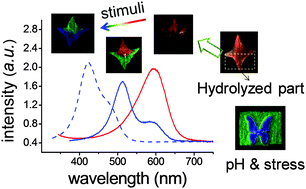Decoupling dual-stimuli responses in patterned lamellar hydrogels as photonic sensors†
Abstract
This work developed a photonic hydrogel that is responsive to, and can distinguish between two stimuli of stress and pH. Patterning is used to locally change the chemistry of a one-dimensional (1D) photonic gel, such that the native region is responsive to mechanical stress while the chemically modified region is responsive to both mechanical stress and pH. By combining the optical signals in the native region and the modified region, one can distinguish the stimuli between pH and stress. Specifically, the native 1D photonic gel is composed of periodically aligned polymeric bilayers in a soft polyacrylamide (PAAm) network. The chemical modification is done by partially hydrolyzing PAAm into sodium polyacrylic acid in some patterned regions, which imparts pH sensitivity, in addition to the stress sensitivity, to these regions.


 Please wait while we load your content...
Please wait while we load your content...